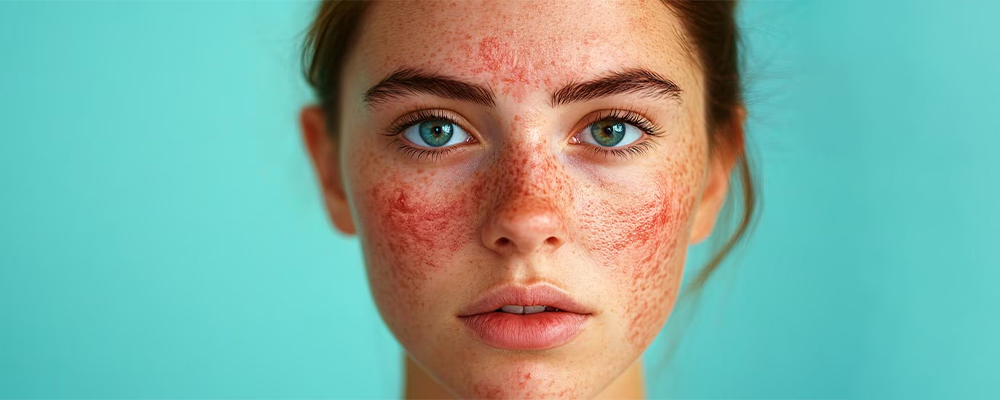Key Takeways:
- Cutaneous lupus is an autoimmune skin condition that causes rashes, scarring, and sensitivity to sunlight (photosensitivity).
- It comes in three main types: discoid lupus, subacute lupus, and acute lupus.
- UV light exposure, genetics, and stress are common triggers.
- Treatment strategies include sun protection, various medications, and lifestyle changes.
- It does not affect internal organs like systemic lupus, but it can still cause serious skin damage.
- Early diagnosis and ongoing treatment are key to preventing long-term complications.
Is your skin trying to tell you something?
If you’ve been noticing unusual rashes after sun exposure, unexplained redness, or patches that won’t heal, it could be more than just a skin irritation. It might be cutaneous lupus, a chronic autoimmune condition that targets your skin and causes lasting damage if left untreated.
While lupus is usually thought of as a disease that harms many parts of the body, cutaneous lupus is more limited. It mostly causes skin problems, though it can still be serious and uncomfortable.
In this blog, we’ll cover what cutaneous lupus is, its symptoms, types, treatment options, and how serious it can be. So, let’s take a closer look at this skin-related form of lupus and how to manage it effectively.
What Is Cutaneous Lupus?
Cutaneous lupus, also known as skin lupus, is an autoimmune condition that mainly affects your skin. In autoimmune diseases, your immune system, which is supposed to protect you, mistakenly attacks healthy parts of your body. In this case, it targets your skin cells, leading to chronic inflammation and noticeable skin rashes, especially on areas exposed to sunlight.
These rashes often come with other symptoms like:
- Itching
- Redness or irritation
- Swelling
- Hair thinning
- Butterfly rashes
- Sores
- Uneven skin pigmentation
Some people may experience mild symptoms, while others may deal with severe skin damage and scarring.
Moreover, several clinical trials are currently underway to better understand the symptoms of cutaneous lupus and to develop potential new treatment options for the future.
What Are The Types Of Cutaneous Lupus?
There are three primary forms of Cutaneous Lupus Erythematosus, each having unique features, symptoms, and triggers. Below is the overview of each type:
Chronic Cutaneous Lupus Erythematosus (CCLE):
This is the most common type, often appearing as discoid lupus erythematosus (DLE). It causes coin-shaped, red, scaly patches that can lead to scarring, pigment changes, and hair loss, typically on sun-exposed areas like the face, scalp, and ears.
Subacute Cutaneous Lupus Erythematosus (SCLE):
Subacute cutaneous lups presents as red, scaly patches that can be annular (ring-shaped) or papulosquamous (psoriasis-like). These lesions are also usually found on sun-exposed skin but heal without scarring, though they can cause pigment changes. Many individuals with SCLE are sensitive to sunlight.
Acute Cutaneous Lupus Erythematosus (ACLE):
This form is often a sign of systemic lupus erythematosus (SLE). It can manifest as a “butterfly rash” (malar rash) across the cheeks and nose, or as widespread, non-scarring rashes that resemble sunburn. ACLE is highly sensitive to sunlight.
What Are The Causes Of Cutaneous Lupus?
Cutaneous lupus is caused by a problem in the immune system, where the body mistakenly attacks its own healthy skin cells. This abnormal immune response leads to inflammation and skin damage. The exact reason why this happens isn’t fully understood, but doctors believe it’s caused by a combination of genetic, environmental, and hormonal factors.
People who have a family history of autoimmune diseases are more likely to develop cutaneous lupus. Certain environmental triggers can also play a big role. Sunlight exposure (UV rays) is one of the most common triggers—many people with cutaneous lupus notice that their symptoms get worse after being in the sun. Other than that, infections, physical stress, emotional stress, and even injuries to the skin may cause flare-ups.
Furthermore, some medications can also trigger a lupus-like skin reaction in certain people. This is known as drug-induced lupus, and it usually goes away once the medication is stopped.
In women, hormone levels (especially estrogen) may contribute to the development of lupus, which is why the condition is more common in females, especially during childbearing years.
While you cannot always control the causes, understanding your personal triggers and working closely with a doctor can help you manage the condition more effectively.
Treatment Options For Cutaneous Lupus
Although there’s no permanent cure for cutaneous lupus, some treatment options can help manage symptoms, prevent flares, and protect the skin. However, it depends on certain factors such as the severity of the disease and the type of skin involved.
Sun Protection
Sun exposure is a major trigger for cutaneous lupus, so daily sun protection is essential.
- Use broad-spectrum sunscreen (SPF 50+) every day, even when it’s cloudy. Reapply every 2 hours when outdoors.
- Wear protective clothing such as wide-brimmed hats, long sleeves, and UV-blocking fabrics.
- Avoid peak sunlight hours (10 a.m. to 4 p.m.) and completely avoid tanning beds.
Topical Treatments
These are applied directly to affected skin areas to reduce inflammation and help heal rashes.
- Steroid creams or ointments are often used first to reduce swelling, redness, and irritation.
- Calcineurin inhibitors (e.g. tacrolimus or pimecrolimus) are non-steroidal options ideal for sensitive areas like the face.
Oral Medications
Used when the condition is widespread or doesn’t respond to creams.
- Hydroxychloroquine is the most common oral treatment for cutaneous lupus. It helps reduce inflammation and control flare-ups.
- Immunosuppressants such as methotrexate or azathioprine may be used in more severe cases to calm the immune system.
Lifestyle Changes
Adopting healthy habits can reduce flares and improve treatment outcomes.
- Manage stress and get enough rest, because stress can worsen symptoms.
- Avoid smoking, because it can make treatments less effective and worsen skin damage.
- Follow a balanced diet and avoid known triggers to support your overall health.
Therefore, with the right combination of treatments, skin care, and lifestyle adjustments, many people with cutaneous lupus can manage their symptoms and prevent long-term skin damage.
Is Cutaneous Lupus Serious?
Yes, cutaneous lupus can be serious, especially if left untreated. It may not affect internal organs like systemic lupus, but it can still cause long-term problems:
- Permanent skin damage and scarring: Without treatment, rashes can become thick and leave lasting scars, especially in chronic types like discoid lupus.
- Hair loss: When the scalp is affected, inflammation can damage hair follicles, leading to permanent hair loss in those areas.
- Skin discoloration: Even after the rash heals, it may leave behind dark or light spots, which can be difficult to reverse.
- Emotional impact: Visible lesions, especially on the face, can lower self-esteem and thus cause emotional distress.
Moreover, cutaneous lupus can sometimes progress into systemic lupus erythematosus (SLE), or it may be an early sign of SLE in some individuals, which can eventually affect internal organs. However, with early diagnosis, proper sun protection, and appropriate treatment, most people can manage their symptoms effectively and lead healthy, active lives.
What Is the Difference Between Cutaneous Lupus And Systemic Lupus?
Cutaneous lupus and Systemic Lupus Erythematosus (SLE) are both forms of lupus, an autoimmune disease, but they are different in how they affect the body.
Cutaneous lupus particularly affects the skin, causing red, scaly rashes and sometimes scarring or hair loss. Unlike SLE, people with cutaneous lupus do not have any damage to internal organs.
Systemic lupus (SLE), on the other hand, is a more serious and complex condition that can affect multiple organs and systems in the body. This includes;
- joints
- kidneys
- heart
- lungs
- brain
- blood vessels
While people with SLE may also have skin rashes (butterfly rash on the face), their condition goes beyond the skin and can lead to life-threatening complications if not properly treated.
In simple terms:
- Cutaneous lupus = skin-bound lupus
- Systemic lupus = whole-body lupus, including skin and internal organs
However, it’s important to know that some people with cutaneous lupus may later develop systemic lupus. That’s why regular check-ups and early treatment are important for anyone diagnosed with lupus.
Conclusion
Cutaneous lupus is a chronic skin condition where the immune system attacks healthy skin, causing rashes, scarring, and discomfort. While it may not affect internal organs, it can still impact your appearance and confidence.
So, if you notice unusual skin changes—especially after sun exposure- consult a healthcare provider immediately. Early care can prevent lasting damage.
Also, if you are looking for advanced care options, contact Hightower Clinical Research Organization and explore new potential treatment options while supporting future breakthroughs.




